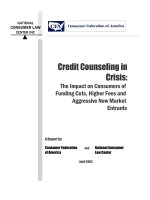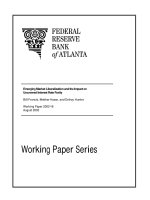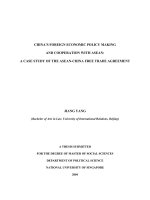EUVietnam Free Trade Agreement: the impact on VN (with a special focus on SMEs)
Bạn đang xem bản rút gọn của tài liệu. Xem và tải ngay bản đầy đủ của tài liệu tại đây (793.84 KB, 26 trang )
EU-Vietnam Free Trade Agreement:
the impact on VN (with a special focus on SMEs)
Presenter: Claudio Dordi
Ha Noi, 12 November 2014
Summary
• Two parts
– Impact assessment of EU-VN FTA
•
•
•
•
•
EU-VN trade
Level of protection
Recent FTA Commitments of EU and VN
Tariffs (export to EU)
Increased trade following the EVFTA
– Support to SMEs
• Perceived barriers to export to the EU
• What kind of support SMEs might need?
• Some basic ideas for further support
2
EU-VN Trade: VN surplus
Blue: import into EU. Red: export to VN. EU Balance
EU trade with Vietnam (2003-2012)
Source: Eurostat (2013) European Union Trade in Goods with Vietnam, November
3
Levels of Protection
• Vietnam’s exports to the EU face an average tariff of
4.6 per cent, but this hides a number of tariff peaks
• EU exporters to Vietnam also face significant
barriers on specific items, most notably on alcohol
and tobacco products, 100 per cent, and motor
vehicles, especially motorcycles.
• Behind the border restrictions, which include nontariff measures are significant in both parties
• Restrictions on services are also extensive
4
Recent FTA Commitments of EU and VN
• EU has liberalised fully or over 99% of its trade over 0-7
years in recent FTAs
• EU has gone beyond GATS in services, and added other
cooperation or commitments for government procurement,
competition policy, investment, TRIPS, trade facilitation and
customs, mutual recognition agreements, dispute settlement,
labour rights, capacity building and sustainable development
• Vietnam has similar trade in goods commitments across
agreements
• Vietnam has tended to stick to its WTO accession protocol for
services and shied away from other trade related areas
5
Tariffs
on Vietnam’s agricultural exports to EU
Source. TASTE 2013 and simulations.
Rice exempt.
6
Industrial tariffs
on Vietnam’s exports to EU
Source. TASTE 2013 and simulations.
7
Vietnam total exports
relative to base
8
Vietnam total imports
relative to base
9
Vietnam gains from services reform
relative to baseline in 2020
Improvements in bilateral access
Welfare gains =$321m.
10
Imports, agriculture
Change in 2020 relative to 2007
11
Imports, industrial
Change in 2020 relative to 2007
12
Exports, agriculture
Change in 2020 relative to 2007
Excludes dairy, forestry.
13
Exports, industrial
Change in 2020 relative to 2007
14
Output
Change in 2020 relative to base in 2007
15
Output in textiles sector
Change in 2020 relative to base in 2020
16
Agricultural Issues
• The agricultural and fisheries sectors are sensitive sectors for both
parties of the negotiations. (use of tariff peaks, subsidisation, income
support, etc.)
• Impact on employment, poverty alleviation and rural development
• Vietnam has significant input requirements across the entire supply
chain of agro-processing sector with a high propensity to import.
• Non-tariff measures are significant (SPS, HAACP, EuropGAP, GAP
etc.)
17
Industry Issues
• VN experienced high growth and competitive in all sectors.
• Three sectors are particularly outward oriented: textiles and
clothing, footwear and handicrafts
• Investment is also drawn significantly to four of these sectors:
textiles and clothing, footwear, high-technology and automotive.
• Inputs often rely on imports
• Rules of origin concerns, standards and investment concerns,
IPRs
18
Services Issues
• VN experienced high growth, major investment and
restructuring in most sectors
• Commitments go quite far for VN
• EU highly competitive in most service sectors
• Problem in VN of implementation, regulations,
licensing and policy uncertainty
• Problem in EU for mode 3 and mode 4 => strong VN
interests. Currently VN exports mainly under mode 1.
• Professional services most complicated to liberalise
19
Perceived barriers to export to EU
• Bureaucratic legal and business environment (including
tax)
• Poor access to sufficient HR
• Cultural differences, language
• Trade barriers
• Access to finance
• Difficulties in identifying foreign business opportunities
(partners networks, contacts overseas)
• Differences between markets and regulations in
different EU members
• Limited information to locate/analyze markets
• Poor access to information and difficulties in obtaining
reliable information
What kind of support SMEs might need?
Coordination in the target country:
experiences of EU SMEs
•
•
Situation
• Enterprises from some Member States are better provided than others
• Parallel services provided by different MS and agencies= often duplication or
inefficiencies
• Competition among different agencies from MS=how to coordinate?
Added value
• Make it possible that SMEs from MS not providing support services in VN can
also get access to services provided by support service organizations from
another MS (EU Business center: hub in the target country linking support
service organizations).
• There are services where there is no competition among different service
providers’ organizations (e.g. technical standard, IPRs, legal environment,
basic market studies, trade information, etc.)
• Is there room for cooperating on trade missions?
• Liaison with Enterprise Europe Network
• Acting as counterpart of coordinating bodies at a NATIONAL level in the EU
(e.g. bringing together the existing agencies, establishing an effective division
of labor, identifying gaps and improving relations with the business support
system “at home”
• Signposting: reference point for enterprises/support agencies in Europe
directing them to the most appropriate form of support
• Efficiency gains (division of labor…is it possible?)
Some basic ideas to further support
- First entry services information (how the country
is, a few brochures on how to recruit, how to deal
with taxes, etc).
- Matchmaking, Trade promotion
- Organize activities, like VN pavilions in trade fairs
- Support to import is equally important to other
support activities!
- Make baseline studies









